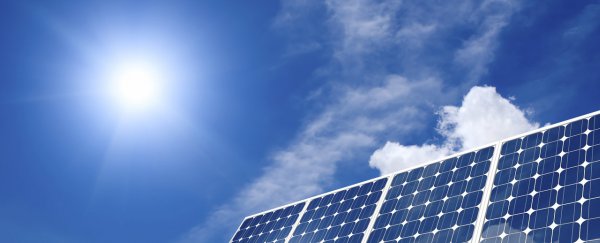A composite perovskite solar cell developed by Korean engineers has achieved a record-setting power conversion efficiency of 20.1 percent.
Importantly, the new cell - described this week in the journal Nature - has also sidestepped issues with performance variability that have plagued other perovskite solar cells.
Crystal structures of hybrid perovskites have, in the last few years, captured the attention of the solar photovoltaic industry and research community.
The first reported perovskite cell, developed in 2009, yielded an efficiency value of only 3.5 percent. But since 2012, efficiencies have dramatically improved.
According to an editorial in Nature Materials, "the exceptional performance of hybrid perovskite materials may revolutionise the field of renewable energy with cheap solar cells having power-conversion efficiencies comparable to those of silicon photovoltaic devices".
Not only are the materials being investigated by researchers more abundant and more affordable than silicon, they are also very good at absorbing light.
According to an article from MIT Technology Review written in August 2013, "while conventional silicon solar panels use materials that are about 180 micrometers thick, the new solar cells use less than one micrometer of material to capture the same amount of sunlight. Furthermore, the pigment is a semiconductor that can effectively transport the electric charge created when light hits it".
The materials are also relatively easy to incorporate into working devices: the pigment can be spread on a sheet of glass, and covered with several layers of other materials that enable the movement of electrons through the cell - sort of like a sandwich.
IEEE's Spectrum points out, however, that two main barriers have impeded "rapid progress" for perovskite solar cells.
The first issue is that the cells' power conversion efficiency often varies depending on how it is measured.
This performance variability - known as hysteresis - was highlighted in the afortementioned Nature Materials editorial, which raised concerns about the validity of efficiency values being reported.
Secondly, researchers have been working on extending the range of the light wavelengths that perovskite cells can trap, and convert to electricity. Doing so is necessary to achieve efficiencies comparable to silicon cells.
Sang Il Seok and colleagues at the Korea Research Institute of Chemical Technology blended one of the more well-known perovskite materials – methylammounium lead bromide - with a similar compound called formamidinium lead iodide.
The latter material is promising because it can absorb light further into the near-infrared, but previous tests have shown it can be unstable.
After testing different combinations, the researchers settled on an 85:15 mixture of the formamidinium and methylammonium perovskites. Their cell proved to be relatively stable, and produced an average efficiency of 18.4 percent.
The researchers say this same blend was responsible for their record-breaking 20.1 percent efficiency cell, which was confirmed in November 2014 by the US National Renewable Energy Laboratory in Golden, Colorado.
"In terms of absolute efficiency, this is probably the highest reported yet," Henry Snaith, a perovskite researcher at the University of Oxford told IEEE's Spectrum.
SOURCE: IEEE's Spectrum
